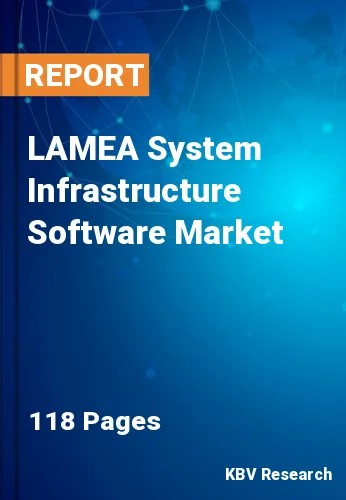The Latin America, Middle East and Africa System Infrastructure Software Market would witness market growth of 11.9% CAGR during the forecast period (2022-2028).
A system that can continuously provision and modify itself with change in traffic is called a dynamic infrastructure. This ensures that assets are used as effectively as possible while minimizing the time and effort required to administer the infrastructure and largely reducing errors. Additionally, IT managers have the option to manually manage these resources.
The systems will run at peak performance levels for longer than unmanaged ones if one practices proactive IT infrastructure management. The IT investments will have the expected life cycle if best practices including maintenance & upgrade schedules, documentation processes, infrastructure monitoring, etc are practiced. The business will save time and money if one can take a proactive approach to infrastructure management.
This can aid in savings both during and after problems are fixed. Vital infrastructure is a foundation for which the components' continuing operation is necessary to guarantee a country's security, economy, and citizens' health and safety. High availability (HA) and resiliency ideas are crucial in this context, frequently involving faraway data centers and cloud resources to facilitate workload redundancy.
In this region, the BFSI industry is rapidly expanding. According to South Africa's International Monetary Fund, South Africa's banking industry is comprised of commercial banks, mutual and cooperative banks, as well as subsidiaries with foreign ownership. Smaller banks are greatly expanding their efforts to maximize their growth and improve client happiness. Large banks have performed quite successfully. With equity capital comprising around 16% of total assets, banking institutions outside of the top five accounts for approximately 10% of total assets.
The Brazil market dominated the LAMEA System Infrastructure Software Market by Country in 2021, and would continue to be a dominant market till 2028; thereby, achieving a market value of $4,425.2 million by 2028. The Argentina market is experiencing a CAGR of 12.5% during (2022 - 2028). Additionally, The UAE market would display a CAGR of 11.6% during (2022 - 2028).
Based on Type, the market is segmented into Network & System Management, Storage, and Security. Based on Application, the market is segmented into Data Center Infrastructure, Building Management, Integrated Communications, and Cloud Integrations. Based on End Use, the market is segmented into IT & Telecom, BFSI, Retail, Manufacturing, Transportation & Logistics, Healthcare, and Others. Based on countries, the market is segmented into Brazil, Argentina, UAE, Saudi Arabia, South Africa, Nigeria, and Rest of LAMEA.
Free Valuable Insights: The Global System Infrastructure Software Market is Predict to reach $237.8 Billion by 2028, at a CAGR of 8.4%
The market research report covers the analysis of key stake holders of the market. Key companies profiled in the report include Amazon Web Services, Inc., BMC Software, Inc., Broadcom Inc., Cisco Systems, Inc., Dell Technologies, Inc., Hewlett Packard Enterprise, IBM Corporation, Microsoft Corporation, Oracle Corporation, and TIBCO Software Inc.
By Type
By Application
By End Use
By Country
Our team of dedicated experts can provide you with attractive expansion opportunities for your business.

